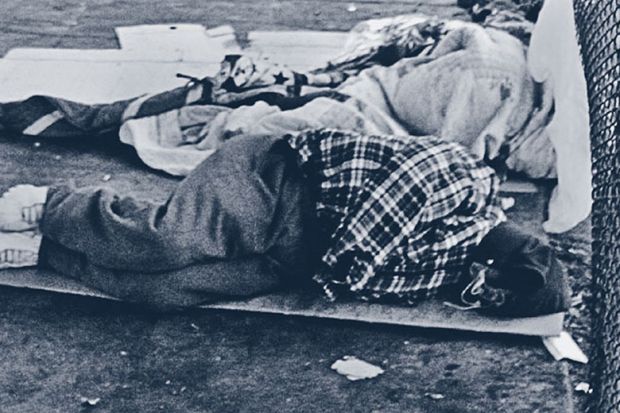The story of the relationship between the police and the urban poor is a familiar one, rife with clichés and lazy assumptions, and usually made without the kind of rigorous empirical evidence provided by Forrest Stuart. He spent five years working on the street corners and in the homeless shelters, flophouses, courthouses and police stations of the Nickel, Los Angeles’ skid row, and shows in unflinching detail how, in the post-industrial city, the view from below is far more complex than orthodox liberal commentators usually allow.
The Nickel is the homeless capital of America and a community of last resort for mainly black, undereducated working-age men, many of whom suffer from physical disabilities, mental illness and addiction. While the Keynesian city utilised welfare to protect its citizens from the vagaries of capitalism, neoliberal poverty governance mobilises the state on behalf of the market, and the administration of the poor has been passed on to the private sector, while some social problems have been deinstitutionalised completely. At the same time, an enlarged police and penal state has decanted less-desirable residents from areas primed for redevelopment and gentrification.
Although neoliberalism has increased welfare expenditure, funding has been diverted from the poorest, for its ideological agenda is to incentivise market behaviour. Police attention has shifted towards quality of life laws that in effect criminalise poverty, and it is here, tasked with reintegrating marginal citizens, that “therapeutic policing” comes to the fore, turning police into de facto outreach social workers.
Stuart describes how police pull denizens of skid row out of queues for food and shelter, and use the threat of incarceration to coerce them to sign up for rehabilitation programmes or employment training. These courses entail a deepening of social control and include devices such as responsibility contracts, drug testing, fingerprinting and paternity tests. Previously non-criminal behaviours are subjected to intrusive regulation; fines can be eliminated by signing up for training for jobs that do not exist; privatised housing is priced far beyond the pockets of people often reduced to street scavenging.
He depicts how the practice of therapeutic policing imbues skid row residents with “cop wisdom”, second-guessing police in order to resist them. He does not romanticise this resistance, but contextualises it within a cultural framework in which skid row citizens competitively distance themselves from their neighbours, presenting at least a facade of willingness to engage in productive behaviour. However, some community groups have become adept at surveillance of therapeutic policing in action, developing tactics for resisting the jagged edges of zero-tolerance policing.
In this fine study, Stuart has put some disturbing flesh on the bones of neoliberalism. His vivid description of the complex worlds of skid row and the widening of coercive social control under the guise of reintegration may remind readers of critiques of social work written in the 1960s and 1970s. This new pathway of disciplinary enterprise, however, is backed up by guns, handcuffs and the threat of incarceration.
Dick Hobbs is professor in the Institute for Culture and Society, Western Sydney University, and emeritus professor of sociology, University of Essex.
Down, Out and Under Arrest: Policing and Everyday Life in Skid Row
By Forrest Stuart
University of Chicago Press, 352pp, £19.50
ISBN 9780226370811 and 70958 (e-book)
Published 12 September 2016
后记
Print headline: The therapeutic arm of the law




